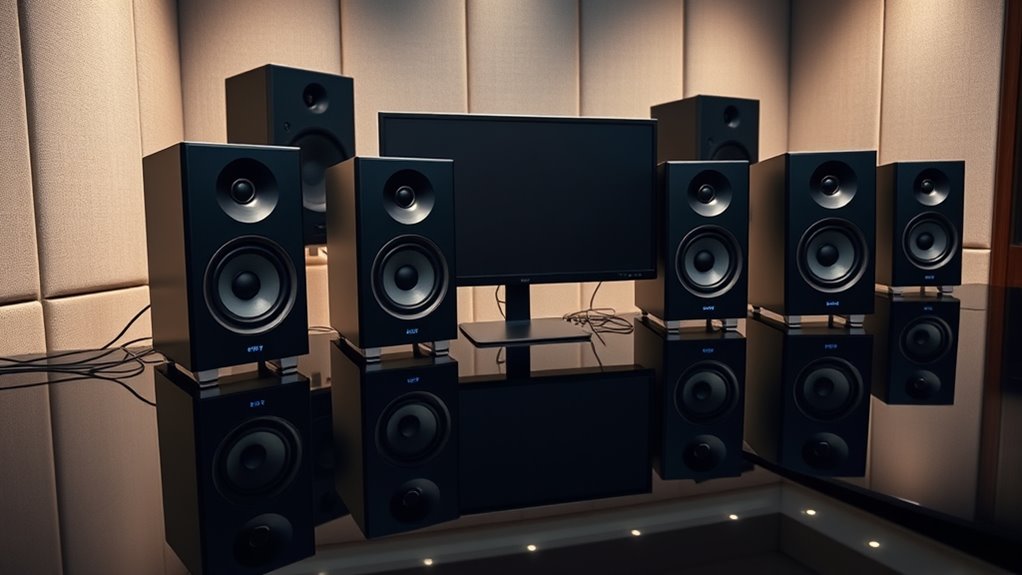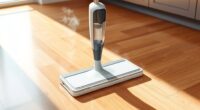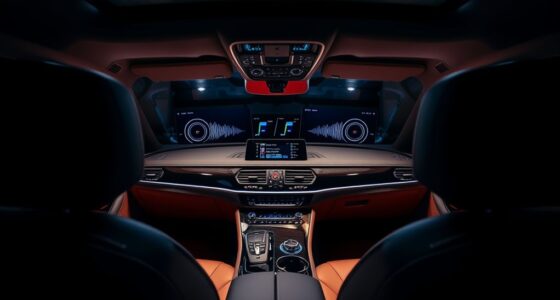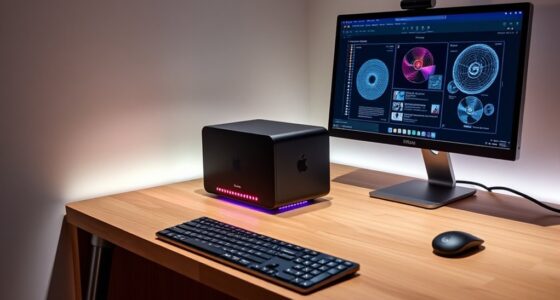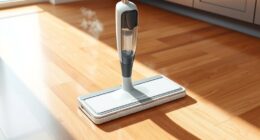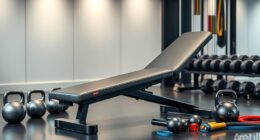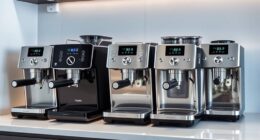If you’re looking for the 15 best studio monitor speakers for precision sound in 2025, I’ve got you covered. I’ve reviewed top picks like the PreSonus Eris series, Yamaha HS models, KRK Rokits, and more, balancing sound clarity, build quality, and versatility. Whether you need compact monitors, Bluetooth options, or studio-grade accuracy, these models cater to various needs. Keep exploring, and you’ll discover detailed insights to help you choose the perfect pair for your setup.
Key Takeaways
- Highlights of top studio monitors emphasize high-fidelity sound, broad frequency response, and precise transient reproduction for professional audio accuracy.
- Designs feature versatile connectivity options including XLR, TRS, RCA, and Bluetooth for broad device compatibility.
- Compact sizes and adjustable features make these monitors suitable for small to medium-sized studios and near-field setups.
- Many models incorporate resonance-reducing enclosures, boundary EQ, and advanced transducers for clearer, more accurate sound.
- Considerations include placement, room acoustics, and potential need for subwoofers due to limited bass extension in smaller monitors.
PreSonus Eris 3.5 Studio Monitors (Pair)
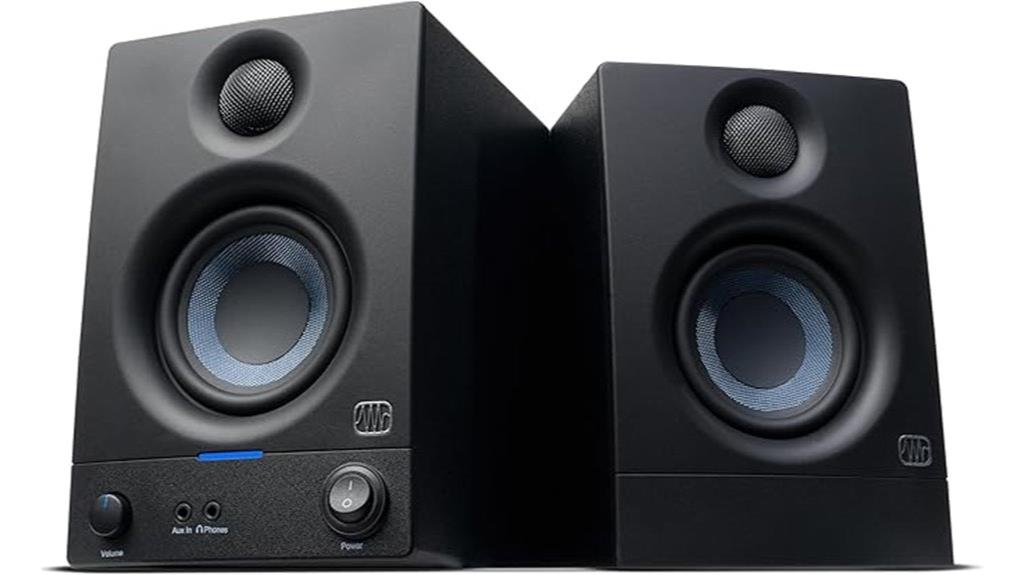
If you’re looking for compact studio monitors that deliver professional-quality sound without breaking the bank, the PreSonus Eris 3.5 pair is an excellent choice. These speakers produce accurate, studio-grade sound with tight bass from woven-composite woofers and natural highs from 1-inch silk-dome tweeters. With 50 watts of Class AB amplification, they offer plenty of volume and clarity. Their versatile connectivity includes TRS, RCA, and aux inputs, making setup easy. Plus, the room tuning controls let me customize the sound to fit my space and preferences. Whether I’m mixing, listening to music, or gaming, they fill my room with crisp, balanced audio.
Best For: musicians, producers, and audiophiles seeking compact, high-quality studio monitors for mixing, listening, or multimedia use.
Pros:
- Accurate, studio-grade sound with tight bass and natural highs
- Versatile connectivity options including TRS, RCA, and aux inputs
- Easy room tuning with adjustable high- and low-frequency controls
Cons:
- Limited to 3.5-inch woofers, which may not suit large or bass-heavy setups
- May require additional acoustic treatment for optimal sound in untreated rooms
- Power output, while ample, might not be sufficient for very large or noisy environments
YAMAHA Hs5 Powered Studio Monitor, Pair

The Yamaha HS5 Powered Studio Monitor pair stands out as an ideal choice for small home studios and professional producers alike, thanks to their precise and neutral sound reproduction. Built with Yamaha’s legacy of accuracy, they deliver a flat response that stays true to recordings, highlighting midrange and high frequencies clearly. Their 5-inch woofer and 1-inch dome tweeter are bi-amplified with 70W total power, ensuring high-resolution audio across 54Hz to 30kHz. With a sleek wood design, rear ports, and balanced XLR and TRS connections, they’re versatile and reliable, perfect for critical listening, mixing, and mastering in compact spaces.
Best For: small home studio owners, professional music producers, and audio engineers seeking accurate and neutral sound monitoring.
Pros:
- High accuracy with flat frequency response for true-to-recording playback
- Compact design ideal for small spaces and desktop setups
- Versatile connectivity options including XLR and TRS for balanced and unbalanced signals
Cons:
- Rear-ported design requires careful placement to prevent bass muddiness
- Tame bass response may necessitate subwoofers for low-end enhancement
- Slightly higher price point compared to entry-level monitors in the same category
PreSonus Eris 4.5BT Bluetooth Studio Monitors
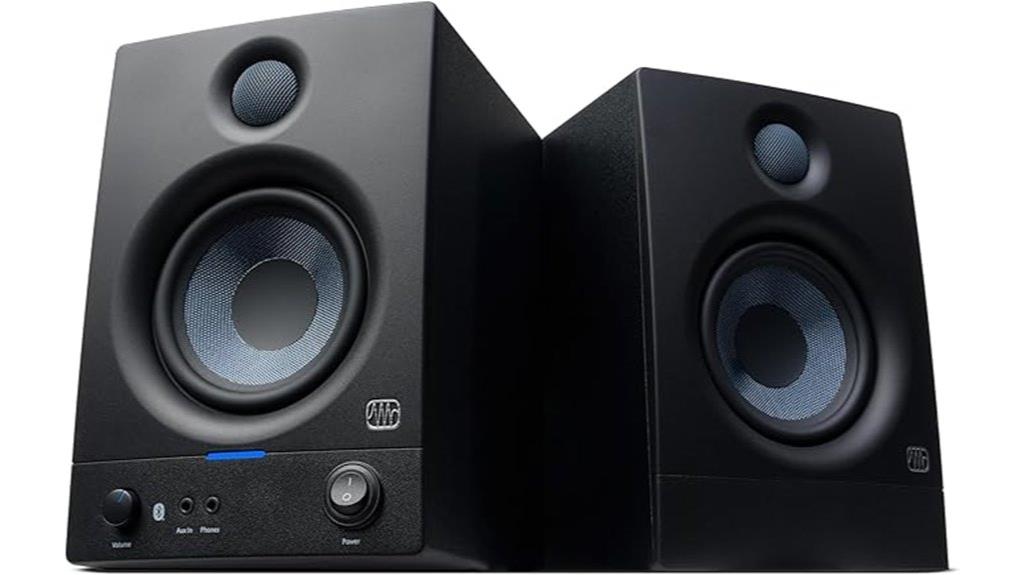
PreSonus Eris 4.5BT Bluetooth Studio Monitors are an excellent choice for anyone who needs compact, versatile speakers for multimedia, gaming, or music production. These powered bookshelf speakers deliver high-quality stereo sound in a small form factor, making them perfect for desktop setups. With 50W of Class A/B amplification, they provide ample volume and clarity without distortion. The 4.5-inch woven-composite drivers produce smooth, powerful bass, while the 1-inch silk-dome tweeters offer wide, natural high frequencies. Multiple inputs—including Bluetooth 5.0, RCA, and TRS—allow flexible connectivity. High and Low Acoustic Tuning controls help customize sound to your space and preferences.
Best For: multimedia enthusiasts, gamers, and music producers seeking compact, versatile Bluetooth studio monitors with high-quality sound for desktop or small room setups.
Pros:
- Compact design ideal for desktop and limited spaces
- Multiple connectivity options including Bluetooth 5.0, RCA, and TRS inputs
- Adjustable High and Low Acoustic Tuning controls for personalized sound calibration
Cons:
- Limited to 50W total power, which may be insufficient for large or noisy environments
- Smaller 4.5-inch drivers may not produce as deep bass as larger monitors
- Bluetooth connectivity can occasionally experience latency or pairing issues
Yamaha HS3 Powered Studio Monitor in Black, Pair (HS3 B)
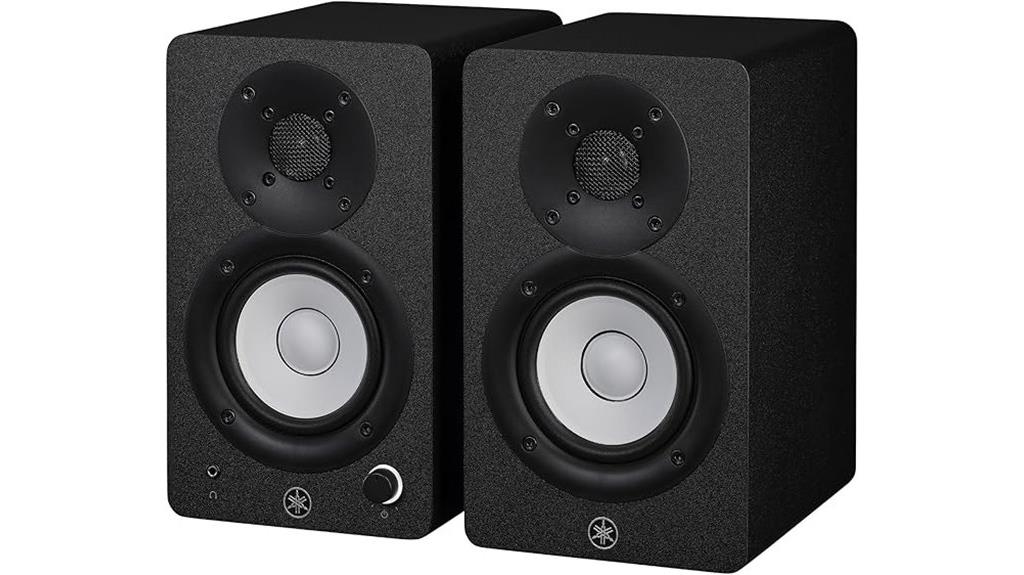
For those setting up a compact yet accurate studio environment, the Yamaha HS3 Powered Studio Monitor in Black, Pair (HS3 B), offers an excellent balance of size and performance. Its 2-way bass-reflex design features a 3.5-inch cone woofer and a 0.75-inch dome tweeter, delivering a frequency response of 70 Hz to 22 kHz. With over 26 W power per speaker, it provides clear, detailed sound suitable for mixing and production. The monitors include room control and high trim response adjustments, along with versatile inputs like XLR, TRS, and RCA. Compact and sleek, they come with essential cables and anti-slip pads, making them ideal for small studio spaces.
Best For: musicians, audio engineers, and producers seeking compact, accurate studio monitors for small to medium-sized studio spaces.
Pros:
- Compact size ideal for limited spaces without sacrificing sound quality
- Versatile input options including XLR, TRS, and RCA for flexible connectivity
- Adjustable room control and high trim response for tailored sound
Cons:
- Frequency response limited to 70 Hz – 22 kHz, which may require subwoofer for full-range bass
- Power output of 26 W per speaker might be insufficient for very loud or large-room setups
- Lacks advanced features like DSP calibration or multiple EQ presets
KRK RP5G5 ROKIT 5 Generation Five 5 Powered Studio Monitor Pair

If you’re looking for accurate, professional-grade studio monitors that can handle critical listening and mixing tasks, the KRK RP5G5 ROKIT 5 Generation Five pair stands out. These monitors feature custom-designed Class D amplifiers for efficient, high-fidelity sound, along with a 5-inch woven Kevlar woofer for deep bass and modal control. The silk dome tweeter extends frequency response up to 40 kHz, delivering crisp high-mids and highs. Their low diffraction baffle minimizes distortion, and acoustic foam pads improve setup. With onboard DSP technology offering three voicing modes and customizable EQ, these monitors adapt to various acoustic environments, making them ideal for precise, professional audio production.
Best For: professional music producers, audio engineers, and serious home studio enthusiasts seeking accurate, high-quality studio monitors for mixing and critical listening.
Pros:
- Exceptional clarity and accurate sound reproduction across low, mid, and high frequencies
- Versatile onboard DSP with three voicing modes for tailored listening experiences
- Robust build quality with sleek, professional design and effective acoustic treatments
Cons:
- Bright LED logo may be distracting in dark studio environments
- Limited to wired connections; no wireless or Bluetooth options
- Requires calibration and setup via the KRK App, which may be complex for beginners
YAMAHA HS5 W 5-Inch Powered Studio Monitor (White, 2-Pack) Bundle (2 Items)
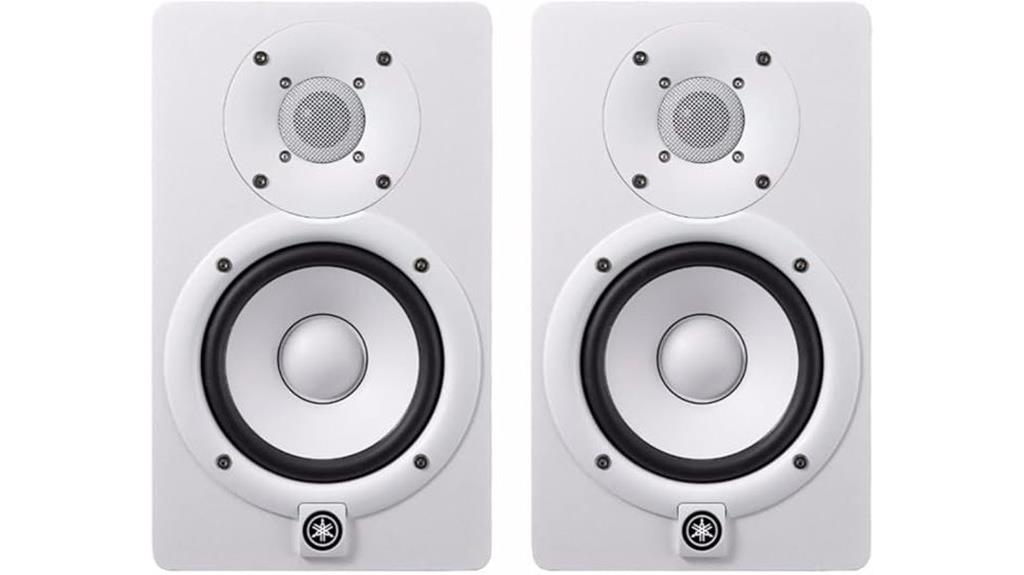
The Yamaha HS5 W 5-Inch Powered Studio Monitor Bundle stands out as a top choice for small studio setups and home musicians seeking accurate, flat sound reproduction. These monitors feature a 2-way design with an 8-inch woofer and a 1-inch dome tweeter, delivering clear mids and a balanced frequency response. Ideal for mixing, editing, and general studio work, they handle high volumes without distortion. With a sleek white finish, solid build quality, and user praise for reliability and aesthetic appeal, they offer excellent performance at a budget-friendly price. This bundle provides two monitors, making it perfect for stereo monitoring in compact spaces.
Best For: small home studios and budget-conscious musicians seeking accurate, flat sound for mixing and editing.
Pros:
- Clear mids with balanced frequency response for precise monitoring
- Sleek white aesthetic and solid build quality enhance studio appearance
- Reliable performance capable of handling high volumes without distortion
Cons:
- Slight spike at 1.5 kHz may affect midrange mixing accuracy
- No wireless or advanced connectivity options included
- Designed primarily for indoor use; not waterproof or outdoor suitable
Ortizan C7 Dual-Mode 2.0 Studio Monitors

When searching for versatile studio monitors that easily adapt to various audio sources, Ortizan C7 Dual-Mode 2.0 speakers stand out. They offer multiple input options, including RCA, 6.35mm TRS, AUX, and Bluetooth 5.3, making switching between devices seamless. The built-in 24-bit DAC guarantees high sound fidelity, while the 3.5-inch carbon fiber mid-bass driver and silk dome tweeter deliver clear, layered audio. Designed as HiFi bookshelf monitors, they’re ideal for small studios, content creators, and musicians. Their professional tuning and multiple connection capabilities provide precise monitoring and creative flexibility, all in a compact, stylish package.
Best For: content creators, musicians, and small studio users seeking versatile, high-fidelity monitoring with easy device switching.
Pros:
- Multiple input options including RCA, TRS, AUX, and Bluetooth 5.3 for seamless connectivity
- High sound fidelity with a 24-bit DAC and professional tuning for accurate monitoring
- Compact bookshelf design ideal for small spaces and versatile use cases
Cons:
- May require careful placement to achieve optimal sound due to room size limitations
- Limited to small studio and near-field monitoring; not suitable for large venues
- Bluetooth connectivity, while quick, may introduce latency issues for critical listening situations
Mackie CR3.5 Studio Monitors with Tone Knob and Location Switch

For those seeking versatile studio monitors that adapt seamlessly to different environments, the Mackie CR3.5 stands out with its switchable desktop and bookshelf modes. This feature optimizes sound placement by adjusting to your setup, whether on a desk or on a shelf. The monitors offer professional-quality sound with a silk dome tweeter and a 3.5-inch woven woofer, delivering clear highs and rich bass. Easy to connect via TRS, RCA, or Bluetooth, they include a tone knob for sound shaping and a location switch for flexible placement. Compact and stylish, they’re perfect for home studios, multimedia, or casual listening.
Best For: musicians, content creators, and multimedia enthusiasts seeking versatile, high-quality studio monitors with adjustable placement features.
Pros:
- Switchable desktop and bookshelf modes optimize sound placement for various setups
- Clear, professional-grade sound with balanced highs, mids, and rich bass
- Easy connectivity options including TRS, RCA, Bluetooth, and a dedicated headphone output
Cons:
- Compact size may limit maximum volume and bass extension for larger spaces
- Tone knob and location switch require manual adjustment, which may be less convenient for some users
- Limited to 3.5-inch woofers, which might not satisfy audiophiles seeking deeper bass
Edifier R1280T Powered Bookshelf Speakers

If you’re seeking a versatile and affordable solution for clear, detailed sound, the Edifier R1280T powered bookshelf speakers stand out as an excellent choice. They deliver 42 Watts RMS power with a balanced sound profile, featuring a 4-inch woofer and silk dome tweeter. The wooden enclosure and vinyl finish add style, fitting seamlessly into home or office spaces. With dual AUX, RCA, and PC inputs, you can connect multiple devices simultaneously. The remote control and side panel knobs offer easy adjustments for volume, bass, and treble. Overall, these speakers provide rich, natural audio ideal for music, multimedia, and casual listening.
Best For: users seeking affordable, high-quality desktop speakers for music, movies, gaming, or multimedia in small to medium-sized rooms.
Pros:
- Clear, balanced sound with rich bass and detailed treble.
- Multiple input options (AUX, RCA, PC) for versatile device connectivity.
- Stylish wood finish with user-friendly remote and side panel controls.
Cons:
- Limited to indoor use; not suitable for outdoor environments.
- Impedance of 4 Ohms may require compatible audio sources for optimal performance.
- Bass adjustment is powerful but can be overwhelming if not fine-tuned properly.
PreSonus Eris 3.5 Studio Monitors (White)
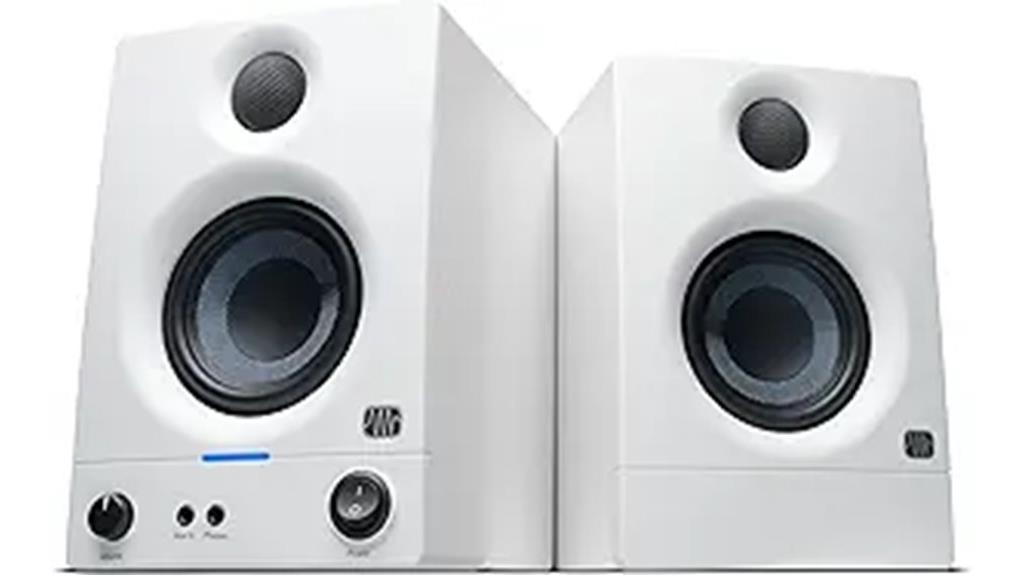
The PreSonus Eris 3.5 Studio Monitors (White) stand out as an excellent choice for those seeking compact, high-quality speakers for desktop music production or multimedia editing. These monitors deliver studio-quality, accurate sound with woven-composite woofers that produce tight bass and clear overall audio. The 1-inch silk-dome tweeters ensure natural high-frequency response and excellent stereo imaging. With 50 watts of Class AB dual amplification, they offer ample volume without sacrificing clarity. Designed for near-field listening, they provide a wide sweet spot and versatile connectivity options, including balanced and unbalanced inputs. Their intuitive controls and sleek design make them perfect for professional and home setups alike.
Best For: musicians, home studio producers, and multimedia enthusiasts seeking compact, accurate studio monitors for desktop or small-room setups.
Pros:
- Delivers studio-quality, accurate sound with clear high frequencies and tight bass
- Versatile connectivity options including balanced TRS, unbalanced RCA, and front-panel aux input
- Compact design with adjustable high- and low-frequency controls for tailored sound
Cons:
- Limited for large-room or high-volume professional mastering environments
- May require positioning adjustments for optimal stereo imaging in certain setups
- Lacks built-in Bluetooth or wireless connectivity options
Edifier MR4 Powered Studio Monitor Speakers (Pair)

Edifier MR4 Powered Studio Monitor Speakers stand out as an excellent choice for casual listeners and home studio enthusiasts seeking high-quality sound without breaking the bank. These active near-field monitors feature a sleek, understated design with MDF wood construction that reduces resonance. Equipped with a 4-inch composite woofer and silk dome tweeter, they deliver a balanced, warm sound with pleasing bass and clear separation. Controls for bass, treble, and volume allow tone-shaping, while multiple wired inputs enhance versatility. Though not perfect—some durability issues with the LED indicator and limited brightness—they offer impressive soundstage and build quality at around $129, making them a compelling, budget-friendly option.
Best For: casual listeners, home studio enthusiasts, and beginners seeking affordable, high-quality studio monitor speakers with a warm sound profile.
Pros:
- Excellent value at around $129 with balanced, clear sound and pleasing bass
- Robust build quality with MDF wood construction and easy-to-access tone controls
- Wide soundstage with good instrument separation and immersive listening experience
Cons:
- Occasional LED indicator durability issues and limited brightness
- Slightly subdued high frequencies, requiring EQ adjustments for clarity
- Lacks waterproofing and wireless connectivity, limiting outdoor or wireless use
JBL 305PMkII 5-Inch Studio Monitor Speaker

For those seeking accurate and reliable studio monitoring in a compact form, the JBL 305PMkII 5-Inch Studio Monitor Speaker stands out as an excellent choice. Designed for near-field listening, it features next-generation JBL transducers with optimized damping for superior transient response, deep bass, and lower harmonic distortion. The Boundary EQ technology guarantees neutral low frequencies whether placed near walls or on surfaces. Its sleek design and wide sound dispersion create a broad sweet spot, making precise mixing easier even off-axis. Included in the package are essential accessories, making setup straightforward. This monitor delivers professional-grade sound quality in a compact, versatile package perfect for various studio environments.
Best For: musicians, producers, and audio enthusiasts seeking accurate, professional-grade studio monitoring in a compact and versatile package.
Pros:
- Next-generation JBL transducers with optimized damping for superior transient response and deep bass
- Boundary EQ technology for neutral low-frequency response regardless of placement
- Wide sound dispersion creating a broad sweet spot for precise mixing even off-axis
Cons:
- May require additional acoustic treatment for optimal performance in untreated rooms
- Designed primarily for near-field monitoring, less suitable for large studio spaces
- Limited to a single speaker in the package, requiring a pair for stereo applications
M-AUDIO BX3 Studio Monitors (Pair, 3.5″, 120W)
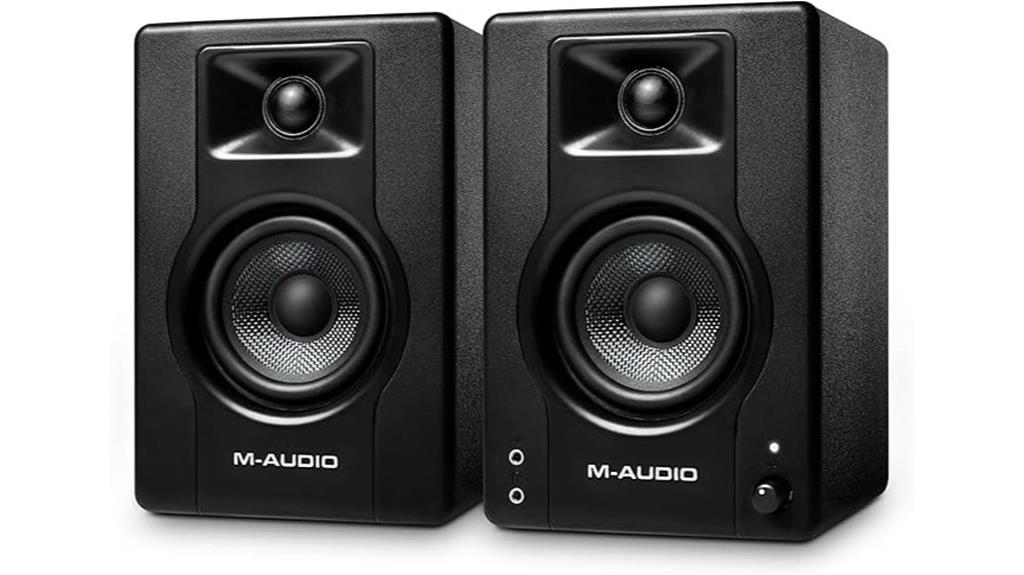
If you’re looking for compact studio monitors that deliver professional-grade sound without taking up too much space, the M-AUDIO BX3 pair is an excellent choice. These 3.5-inch, 120W speakers are versatile, ideal for recording, streaming, gaming, and music production. They feature a bass reflex design with Kevlar low-frequency drivers and silk dome tweeters, ensuring deep, clear sound. With high and low EQ controls and multiple connectivity options—1/4”, 1/8”, and RCA inputs—they’re adaptable to various setups. Plus, the package includes cables and music software, making them a convenient, powerful solution for precise audio monitoring in any small space.
Best For: musicians, podcasters, streamers, and gamers seeking compact, professional-grade studio monitors with versatile connectivity for small spaces.
Pros:
- Compact size with powerful 120W output delivers clear, studio-quality sound.
- Versatile connectivity options including 1/4”, 1/8”, and RCA inputs for easy setup with various devices.
- Includes both passive and active speakers along with cables and music production software for a complete solution.
Cons:
- 3.5-inch drivers may not provide the deep bass of larger monitors for bass-heavy genres.
- Limited size might not suit those needing larger, more immersive soundstage.
- Requires careful placement due to rear port design to avoid bass distortion in small spaces.
Edifier MR4 Powered Studio Monitor Speakers

These powered studio monitor speakers are an excellent choice for artists and music creators seeking professional-quality sound in a compact design. The Edifier MR4 features a sleek black finish and is based on highly rated bookshelf speakers, professionally tuned for a flat, responsive sound. Its MDF wood texture reduces resonance, ensuring true sound reproduction. Equipped with a silk dome tweeter and four composite woofers, it delivers clear, smooth, and accurate audio suitable for both studio work and casual listening. With versatile connectivity options—including TRS, RCA, AUX, and a headphone jack—and dual modes for production or casual use, the MR4 offers both flexibility and precise control in a compact package.
Best For: artists, music creators, and audio enthusiasts seeking professional-quality sound in a compact, versatile monitor setup.
Pros:
- Professionally tuned for a flat, responsive sound ideal for accurate music production and casual listening
- Multiple connectivity options including TRS, RCA, AUX, and headphone jack for versatile device compatibility
- Compact design with MDF wood texture reduces resonance, ensuring true sound reproduction
Cons:
- May require additional space for optimal placement in smaller setups
- Limited to near-field listening, which might not suit large studio environments
- Controls for high and low frequency adjustments may be too basic for advanced sound tuning
ADAM Audio D3V Active Desktop Monitors (Pair, Black)
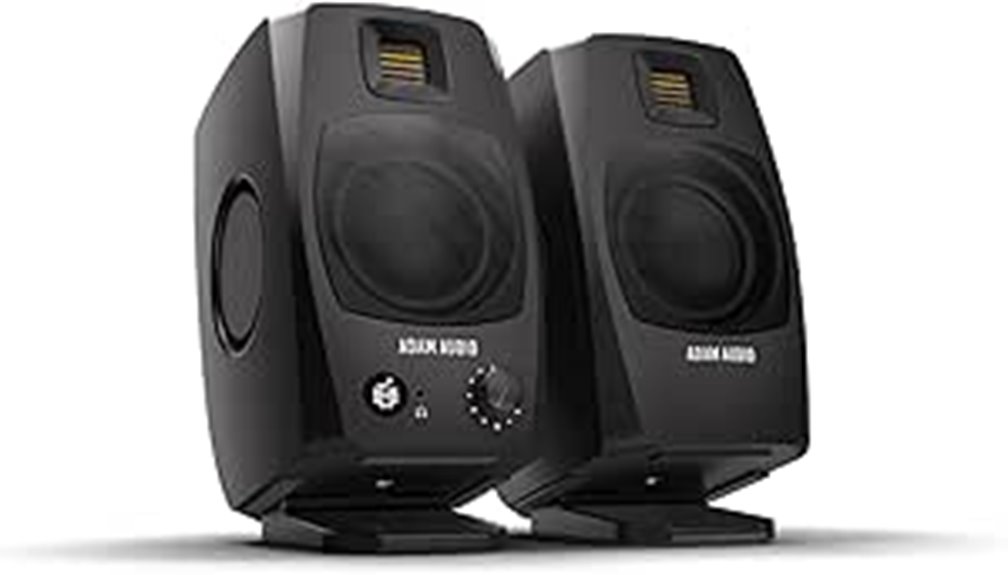
The ADAM Audio D3V Active Desktop Monitors stand out as an ideal choice for musicians and producers seeking high-quality sound in a compact design. These monitors feature ADAM’s iconic golden ribbon tweeter and a sleek black finish, making them stylish and functional. With 3.5” aluminum woofers, dual passive radiators, and 80 W amplifiers, they deliver punchy bass and detailed highs down to 45 Hz. Their DSP tuning and adjustable stands ensure excellent placement. Connectivity is straightforward with USB-C and TRS inputs, plus a headphone jack. Overall, their precise sound, robust build, and user-friendly features make them perfect for near-field studio work or casual listening.
Best For: musicians, producers, and audio enthusiasts seeking high-quality, compact near-field monitors for studio, mixing, or casual listening.
Pros:
- High-fidelity sound with punchy bass and detailed highs down to 45 Hz
- Compact and stylish design with adjustable stands for optimal placement
- Versatile connectivity including USB-C and TRS inputs, plus headphone jack
Cons:
- Lack of Bluetooth connectivity for wireless streaming
- Manual input switching required due to absence of auto-sense feature
- Slight hiss over USB connection at higher volumes
Factors to Consider When Choosing Studio Monitor Speakers
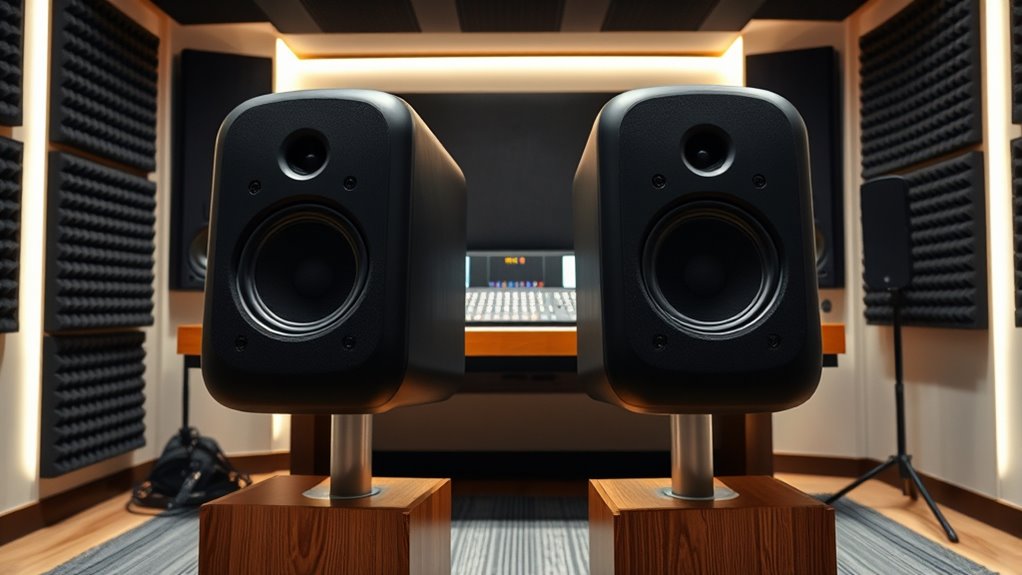
When selecting studio monitor speakers, I focus on several key factors that impact performance. Things like frequency response range, power output, and connectivity options are vital to match your setup and needs. Plus, considering sound clarity and placement flexibility helps guarantee you get accurate mixes every time.
Frequency Response Range
Understanding the frequency response range of studio monitor speakers is essential because it determines how accurately they reproduce sound across the entire audible spectrum. This range indicates the frequencies a monitor can reliably produce, from deep bass to crisp highs. Typically, monitors cover from around 20 Hz to 20 kHz, encompassing all sounds humans can hear. A wider response range enables more detailed and accurate sound reproduction, which is vital for mixing and mastering. Equally important is the monitor’s ability to deliver a flat, neutral response, ensuring the sound remains true to the original recording without coloration. Material quality and driver design greatly influence this range, with high-quality components providing a more consistent and extended frequency response, allowing for more precise audio work.
Power Output Levels
Power output levels play a essential role in selecting the right studio monitor because they determine how loud and clear the sound can be without distortion. Higher wattage usually means the monitor can produce greater volume and headroom, which is indispensable for accurate monitoring at high levels. The power rating, often expressed in watts (W), directly influences the monitor’s ability to deliver clear, undistorted sound across different volume ranges. It’s indispensable to match the power output to your room size and listening needs; underpowered monitors may struggle to reach necessary levels, while overly powerful ones can cause distortion or damage if driven beyond their ideal range. Finding the right balance ensures your monitoring is precise, without risking sound quality or equipment safety.
Connectivity Options
Choosing the right connectivity options is key to ensuring your studio monitor seamlessly integrates with your existing audio setup. I look for monitors with a variety of inputs like XLR and TRS, which are balanced and help reduce noise, delivering clearer sound for professional work. RCA and ⅛-inch AUX inputs are common for connecting consumer electronics and portable devices, but they can be more prone to interference. Some monitors now include Bluetooth or wireless capabilities, offering convenience for streaming, but wired connections typically provide more reliable, high-fidelity audio. The type and number of inputs directly impact compatibility with your gear and the ease of setup. Ensuring your monitors support your preferred connection types is essential for a smooth, noise-free audio experience.
Placement Flexibility
Proper placement of studio monitors is essential for achieving accurate sound and ideal bass response. Avoiding direct contact with walls prevents unwanted reflections and vibrations that can muddy the sound. Monitors with adjustable mounting options or multiple placement configurations give you the flexibility to optimize sound quality for your room’s unique acoustics. The ideal listening position forms an equilateral triangle with the monitors, which often requires adjustable stands or wall mounts for precise placement. Recessed or wall-mounted monitors can further reduce vibrations and reflections, making setup easier in tight spaces. Wide dispersion characteristics and adjustable angles also help improve stereo imaging and room coverage, regardless of placement constraints. These features ensure you can tailor your setup for consistent, accurate monitoring in various studio environments.
Sound Clarity Accuracy
To achieve true sound clarity and accuracy in your studio monitoring, it is vital to focus on the quality of the drivers and the speaker’s overall design. High-quality drivers, like silk dome tweeters and woven composite woofers, deliver detailed, natural sound that reveals every nuance. A flat frequency response ensures the audio output closely matches the original recording, without colorations or emphasized ranges that can skew mixes. Precise stereo imaging allows for clear separation of instruments and vocals, making subtle details easier to identify. Additionally, minimizing distortion at various volume levels preserves clarity during long sessions or high-volume playback. Proper acoustic treatment and strategic monitor placement further enhance sound clarity by reducing reflections and phase issues, guaranteeing your mixes are accurate and true to life.
Size and Space
When selecting studio monitor speakers, it’s important to take into account the size of your room and available space. Smaller monitors, around 3.5 to 5 inches, work well in compact environments, while larger speakers, 6 inches or more, are better suited for bigger rooms, offering deeper bass and wider frequency response. Keep in mind that the physical footprint of the monitors impacts your desk or shelf space; measure your area beforehand to guarantee a comfortable fit. Proper placement is critical—position monitors at ear level and keep them away from walls to minimize reflections. If you choose rear-ported speakers, allow space behind them to prevent bass muddiness. Balancing size and room layout ensures ideal sound quality without clutter.
Build and Durability
Choosing studio monitor speakers isn’t just about sound quality; their build and durability play a significant role in long-term performance. I look for models with high-quality materials like MDF wood or metal enclosures, which resist resonance and physical damage. Reinforced joints and sturdy grills are essential to protect internal components from impact and wear. Well-constructed monitors often feature vibration-dampening elements such as rubber feet or isolation pads, helping reduce unwanted resonance and extend lifespan. Enclosures designed with sealed or ported systems should be made from robust materials to withstand frequent handling and environmental stress. Additionally, reliable internal wiring and connections are fundamental to prevent signal degradation and corrosion, ensuring consistent, high-quality sound over time. Durability is key for maintaining performance in a busy studio environment.
Budget and Value
Setting a realistic budget is essential to finding the right studio monitor speakers, as it helps you focus on features that matter most—like sound quality, durability, and connectivity—without overspending. Higher-priced monitors generally offer more accurate sound reproduction, better build quality, and advanced tuning options, which are valuable for professional work. However, comparing the cost-to-performance ratio is key since some budget-friendly models surprisingly deliver accurate sound for casual or intermediate use. Knowing your specific needs—whether for casual listening, multimedia, or critical mixing—guides you toward monitors that provide the best value. Additionally, considering the longevity and reliability of your speakers ensures your investment remains worthwhile over time, especially if you plan to use them extensively. Balancing cost and performance helps you make a smarter, more satisfying choice.
Frequently Asked Questions
How Do Studio Monitor Speakers Influence Mixing Accuracy?
Studio monitor speakers directly impact my mixing accuracy by providing a true, uncolored sound. When I use high-quality monitors, I can hear every detail, from subtle nuances to bass responses, without exaggeration or distortion. This clarity helps me make precise adjustments, ensuring my mix sounds balanced on any system. Good monitors serve as a reliable reference, so I trust my decisions and achieve professional-quality results every time.
What Is the Typical Lifespan of Studio Monitor Speakers?
Think of studio monitor speakers as musical companions that age like fine wine. Typically, they last around 5 to 10 years, depending on usage and care. I’ve found that with proper maintenance—keeping them clean, avoiding volume extremes—and using quality components, they can serve me well for many years. Like a trusted friend, a well-maintained monitor continues delivering accurate sound, ensuring my mixes remain precise over time.
Are There Specific Room Treatments Recommended for Optimal Sound?
Absolutely, I recommend using bass traps in the corners, acoustic panels on the walls, and a diffusive surface behind your monitors. These treatments help reduce reflections, standing waves, and echo, resulting in clearer, more accurate sound. I’ve found that a well-treated room allows my monitors to perform at their best, giving me a true representation of my mix. Proper room treatment truly makes a noticeable difference in sound precision.
How Does Speaker Placement Affect Sound Quality in a Studio?
Speaker placement directly impacts sound quality because it influences how sound waves interact within your space. I always position my monitors at ear level and form an equilateral triangle with my listening position. I keep them away from walls and corners to avoid reflections that muddy the sound. Proper placement guarantees accurate imaging and clarity, helping me hear every detail for precise mixing and mastering.
What Maintenance Is Required to Keep Monitors Performing Well?
Think of your monitors as delicate plants that need care to thrive. I regularly dust the speakers and keep them in a dust-free environment. I check the wiring connections and make sure they’re secure, and I occasionally calibrate the settings to keep sound accurate. If I notice any rattling or distortion, I troubleshoot immediately. Proper maintenance keeps my monitors singing, ensuring I get precise, clear sound every time I work.
Conclusion
Choosing the right studio monitor can seem overwhelming, but remember, it’s about finding speakers that match your space and style. Some worry about budget, but investing in quality monitors pays off with clearer, more accurate sound. Don’t settle for cheap alternatives, as they can mislead your mixes. Trust me, taking the time to pick the right pair now guarantees your music sounds professional and polished every time you hit record.
